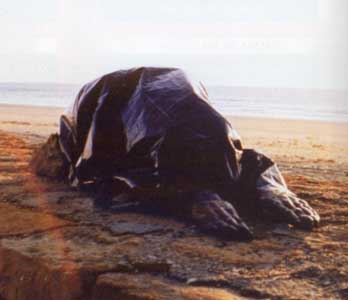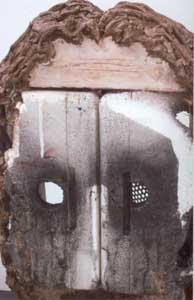




“I think Jesus would be horrified at what’s going on,” Huma Bhabha quipped in front of J.C., her rendition of a shell-shocked son of God fashioned from scavenged wood and Styrofoam with clay accents. Standing in Salon 94’s guestroom last fall, where the harrowing bust starkly contrasted subtle furnishings, Bhabha contextualized it as a response to the Iraq War. Not only does the gritty piece embody the artist’s ability to push religious and political hot buttons, it showcases her skill in crafting grotesque portrait sculptures of larger-than-life characters.
Though Bhabha’s appropriation of Christ’s identity for her own ends cleverly critiques the proclivities of U.S. politicians, the distressed-looking figure’s real impact is its Janus faced identity. From one side, a blackened face made from ripped Styrofoam suggests an injured victim while on the reverse, a second visage appears wearing a rusty metal grill recalling a soldier’s makeshift armor.
Ambiguity defines the hunched form of another sculpture - an untitled, black clad figure apparently bent in prayer from which a tail of rubble extends. To Bhabha’s chagrin, the press interpreted the piece as a comment on Muslim women when it appeared in the blockbuster young art show ‘U.S.A. Today’ at London’s Royal Academy last fall. The artist sees the piece as sexless; clad in a body bag, not burkha, it’s intended as a disintegrating “monument to the hundreds of thousands of dead” in the Middle East.
Though Bhabha sees her artistic role as partly political (to “bear witness if nothing else,”) she is equally committed to forging a provocative formal vocabulary. To this end, she mines familiar figures from art history in fantastical portraits like Man of No Importance (a Cyclops whose head is his body), and Waiting for a Friend, (a female fertility figure bleeding from the waist), recasting her characters with newly uncertain identities.
Sleeper, a standing male figure with a stiff posture reminiscent of a Greek kouros and an economic construction suggesting an African artifact, looks at once like a battered but noble antique sculpture and a creepy contemporary character with oddly delicate features. His pronounced derriere is a comic detail observed only from the back and side, above which is a vividly blue framework - like shelving or an empty shadowbox - that turns the man vaguely mechnical.
Photographs often fail to do justice to Bhabha’s multifaceted sculptures, which yield different impressions when viewed from the front, back or side and reward close inspection of their intricate details. Early last year, the formal refinement of the sculptures in Bhabha’s second New York solo show at ATM Gallery moved veteran New York Times critic Roberta Smith to declare them, “close to perfect.” With their ambitious subject matter, from Christ to kouros, and endless suggestiveness, they continue to move even closer.
-Merrily Kerr